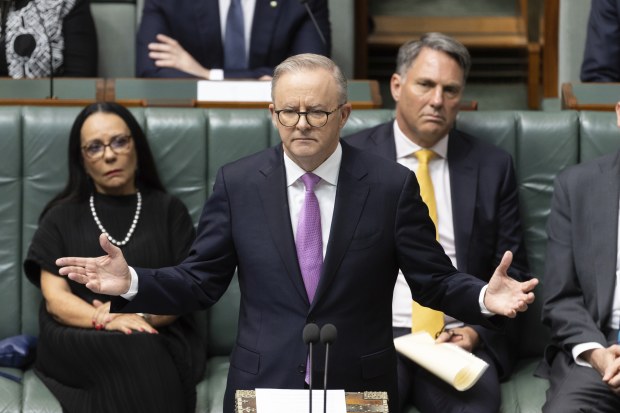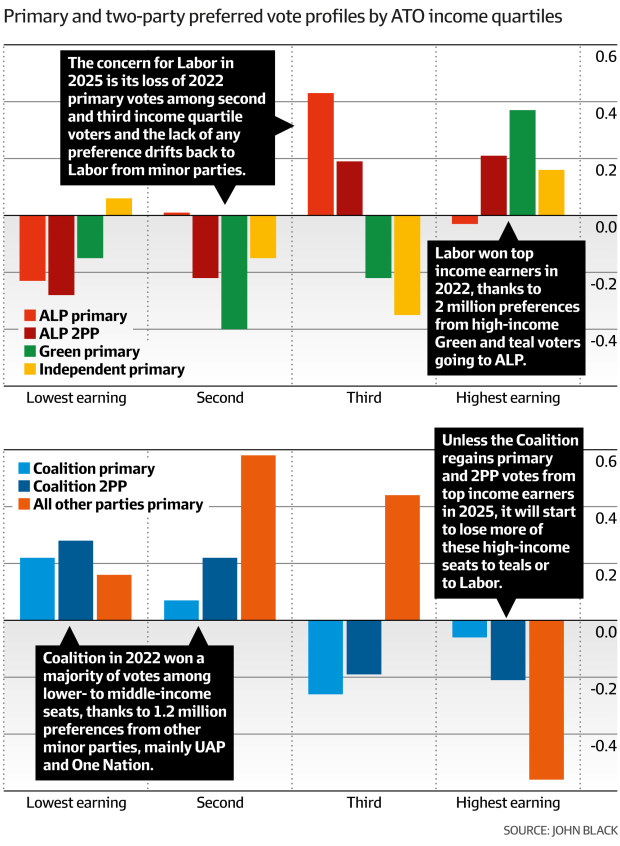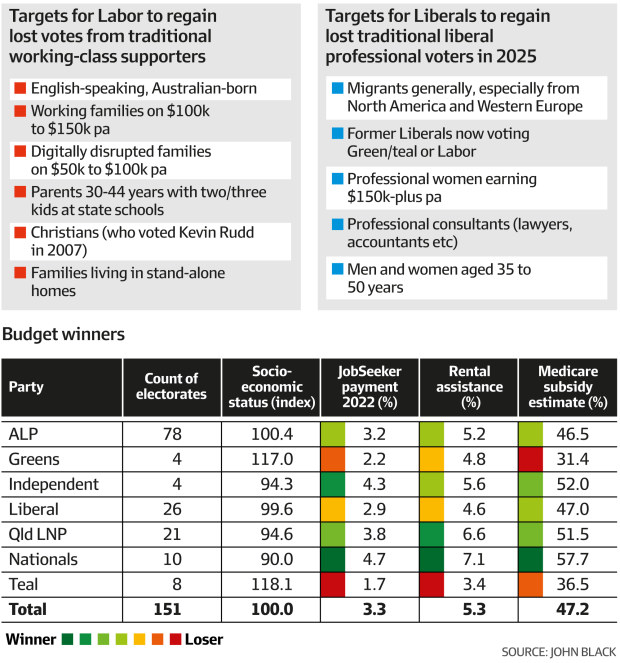Opinion

It’s less rosy than it looks for Labor
The next two years look a lot tougher and, like Howard in 1998, Albanese would be well advised to take some substantial economic reforms to the next election.
John BlackElection analystAfter he’s had a year in the job, it seems almost disrespectful to criticise Labor Prime Minister Anthony Albanese. Seeing him on the nightly news has become kind of comfortable and familiar, like slipping into last year’s Ugg boots on a chilly night.
I guess it’s because Albanese is the closest leader Labor has had in recent times to former Liberal PM John Howard. Our Labor bloke’s had the teeth fixed, got the senior’s version of the Harry Potter specs and he’s even lost a bit of weight, which is hard to do when you’ve hit 60. Right?

Anthony Albanese in parliament. Alex Ellinghausen
So, how secure is our Labor-lite version of John Howard? How did it come about and what could possibly turn it to custard and see Dig-Me-Up Dutton rise from the political dead to become Australian PM in 2025?
Or, worse, could we see Labor forced to endure the economic night terrors of a Gillard-style minority Labor government, where every decision had to be rubber-stamped by a feast of independent egos or worse, by the increasingly shrill and divided Greens, now led by Adam “Angry” Bandt and “Mad” Max Chandler-Mather? How dare you!
Following a couple of decades of carpet bombing each other with relentless negative campaigning, the Coalition and Labor were left after the 2022 election with demographic profiles resembling downtown Bakhmut, with primary votes of 32.6 per cent for Labor and 35.5 per cent for the Coalition.
This meant that Labor and the Coalition won only 15 seats on primary votes, making the two-party-preferred concepts obsolete in the other 136 seats. In these seats, what mattered was the primary votes for the minor parties and independents and where they allocated their preferences.
Labor won 4.8 million primary votes to secure eight seats and the other 69 were won with preferences from 2 million Green and teal voters and another 800,000 supporters of others (mainly One Nation and UAP, along with an assortment of the usual mad, lonely and ambitious candidates).
The Coalition parties won their seven seats with 5.2 million primary votes and another 50 seats with preferences from 1.2 million others and 540,000 Green and teal voters.

Labor actually lost 0.8 per cent of its primary votes in 2022, but gained a 2PP swing of 3.7 per cent by picking up almost 20 per cent of 4.6 million votes via preferences bestowed by the grace and favour of some characters you wouldn’t invite home for Sunday roast with the kids.
By 2022, the Queensland Liberal party had experienced a reverse takeover by the conservative Queensland Nationals, to produce an equally conservative Queensland LNP. After the teals and Greens defeated eight Liberal moderates, this left the Coalition with a conservative male Queensland LNP leader in Peter Dutton and a conservative male Queensland LNP deputy leader in David Littleproud.
During the first 12 months of Labor’s term in government, these two blokes were never going to win back voters from some of richest, diverse, multicultural and professional seats south of the Tweed, in the leafier suburbs of Melbourne and Sydney.
The polls since the election have borne this out and the result in Aston on April Fool’s Day proved it. Our modelling of the Aston 2022 2PP vote showed Labor’s Mary Doyle would have been on about 52 per cent in 2022.
But Doyle polled even better than this in 2023, to win 53.6 per cent, in a historic by-election Labor won from the opposition, which has been increasingly siding with the Greens to damage their own dwindling supply of Liberal voters in marginal seats, with the apparent aim of winning back the ‘base.’
What about the budget?
So, did the budget change anything? From Labor’s point of view, the government made a start at winning back those demographics it has lost to UAP and One Nation by springing for increases in JobKeeper, rental assistance and the Medicare subsidy.
These policies were pretty skilfully targeted to voters in the bottom three quartiles, from pensioners, through to the semi-skilled and up to skilled blue-collar workers and their families.
The budget had the Howard touch, whereby a vote-hungry PM raided the piggy bank of his more prudent treasurer Peter Costello. Albanese has continued the tradition with gentleman Jim Chalmers.

Peter Dutton’s reply, on the other hand, played to the conservative Queensland LNP base and showed no interest in winning back seats lost to the teals south of the Tweed or even in his own state, where LNP seats such as Ryan and Brisbane, and Labor’s seat of Griffith, were lost to the Greens in 2022.
Looking ahead, the major election signposts to a 2025 federal election are starting to line up, starting with the Voice referendum later this year, and the signs aren’t as rosy for Albanese.
The polls are showing that the referendum, without bipartisan support, is heading for defeat. Constitutional recognition and a legislated Voice could still win, but Albanese would need to offend a few mates here. It’s called leadership for a reason.
Passing by the NT and ACT polls in the second half of 2024, as one tends to do, we’re left with the Queensland election scheduled for October 26, 2024.
In office since March 2012, a tired Labor government and Premier Annastacia Palaszczuk have been promoting too many wasteful vanity projects, such as the plan to spend $2.7 billion knocking down and then re-building our beloved Gabba and a nearby historic primary school.
Labor is heading for a loss here, against a non-threatening LNP Leader David Crisafulli and the opportunistic Greens set to exploit the Gabba traffic chaos and win more of Labor’s inner-city seats from angry voters.
Albanese would be well advised to stay out of this train wreck and then wait until some gloss is off a new LNP government. This would be pretty hard to do if he’s planning a double dissolution to knock over the federal Greens in inner-city Brisbane. So that idea is presumably scratched. Shame really.
One bright spot on the horizon for Labor is the Western Australia election set for March 8, 2025.
Our 2022 election modelling showed Labor Premier Mark McGowan’s government was worth a flat 6 per cent to all federal Labor WA candidates and this in turn delivered a narrow majority government to Albanese with hapless right-wing WA Liberals losing four seats to Labor and one to the teals.
McGowan holds 53 out of 59 state seats and can’t lose in March 2025, despite presumably shedding some of his unexpected 2021 gains. This bloke knows how to run an economy and is a rock star for federal Labor wanting a second term.
One Labor premier who doesn’t appear to know how to run an economy is Victorian Daniel Andrews, whose government’s fiscal performance is beginning to resemble that of Joan Kirner, minus the polka dots.
And unfortunately for Albanese, the Victorian Labor government will be around until November 28, 2026, well beyond the federal election date, showering higher taxes on voters in all those Victorian marginal seats.
All in all, Albanese has had a dream run for the first 12 months, although the next two years look a lot tougher and, like Howard in 1998, he would be well advised to take some substantial economic reforms to the next election, to make it a contest worth the winning.
Peter Dutton as opposition leader, is an asset to be treasured, but he’s not going to be around forever.
Introducing your Newsfeed
Follow the topics, people and companies that matter to you.
Find out moreRead More
Latest In Politics
Fetching latest articles